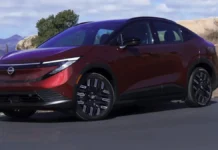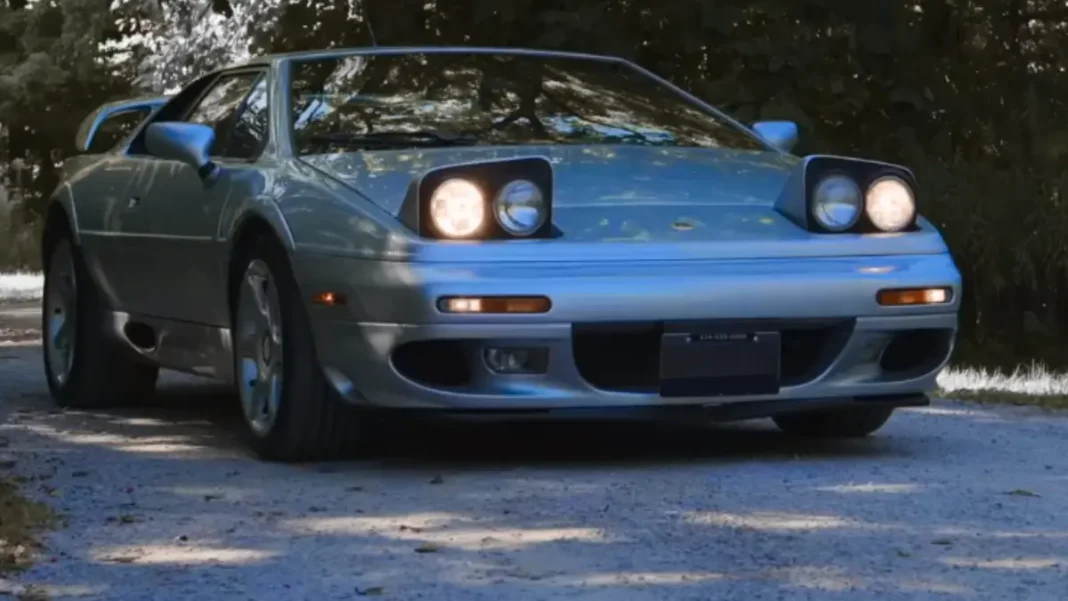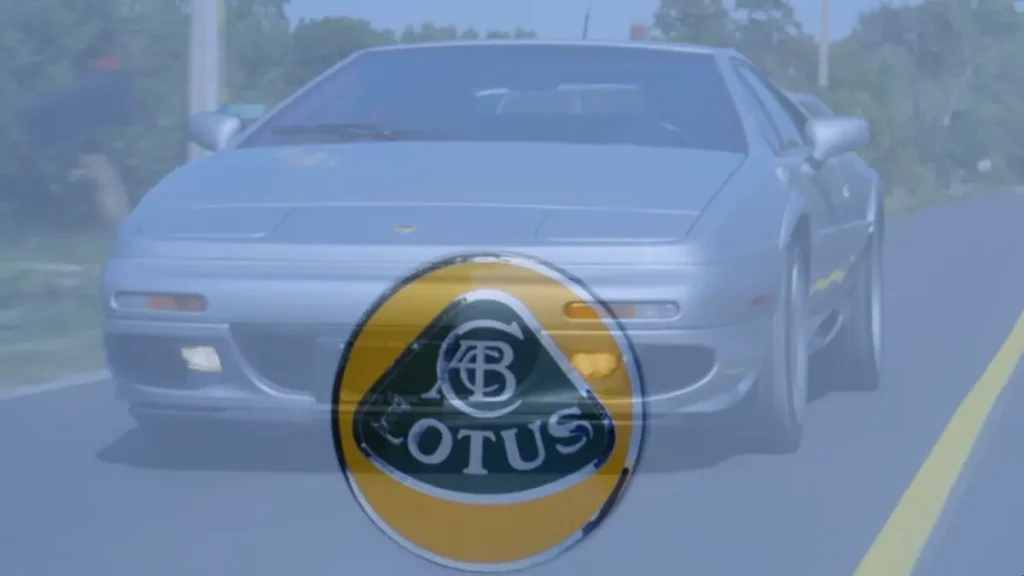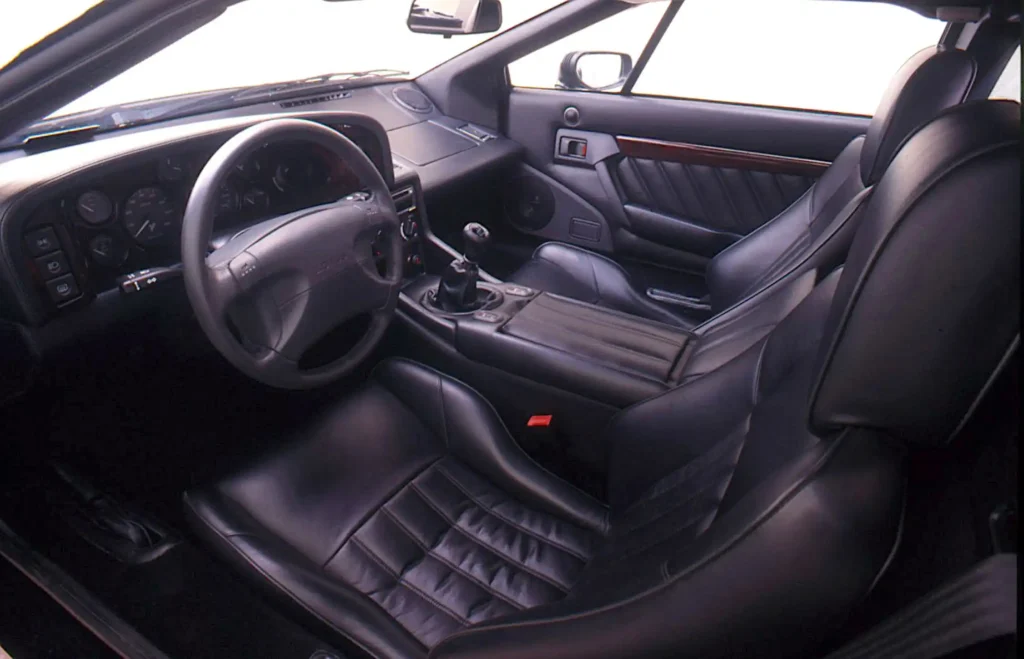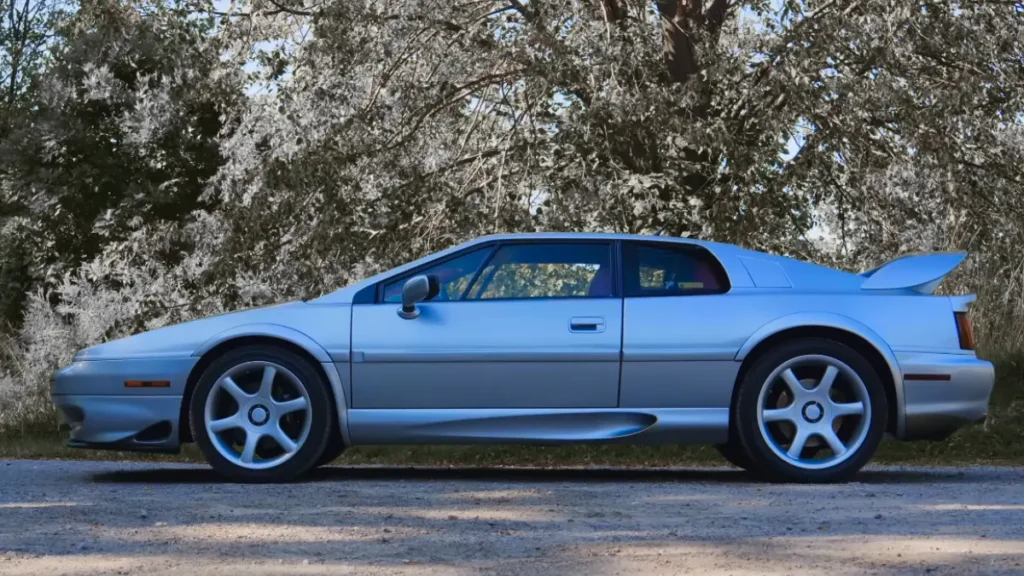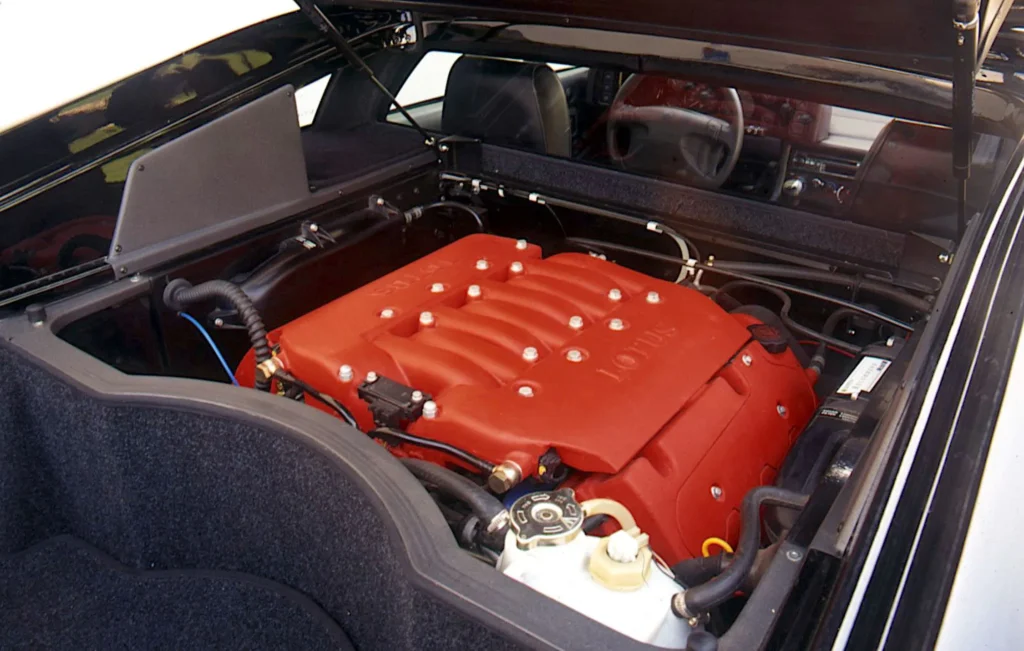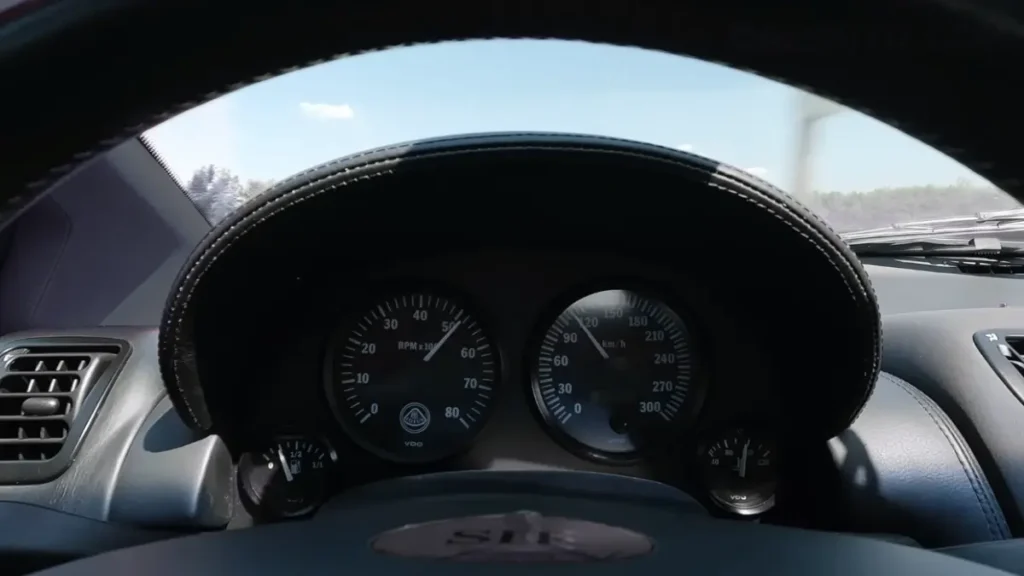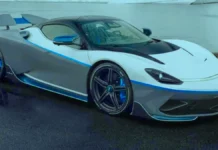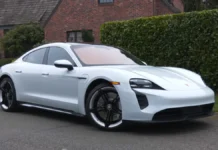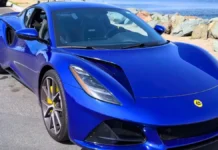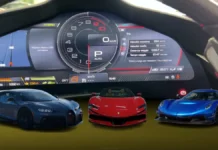Table of contents
- Why the Lotus Esprit V8 Matters
- Background – The Esprit Line Before the V8
- Launch of the V8 (1996) – What Changed
- Variants & Evolution: 1996–200 4
- Technical Deep Dive & Specification Table
- Strengths, Weaknesses & Market Reaction
- Why the Esprit V8 Still Stands Out Today
- Buying & Ownership Insight
- Final thought
- Lotus Esprit V8 FAQs
Why the Lotus Esprit V8 Matters
The Esprit V8 stands as the pinnacle of the Esprit line: a compact, twin‑turbo V8 mid‑engine car that combined Lotus handling expertise with significantly increased power and refinement. It restored the Esprit’s performance credibility against rivals and became the marque’s halo model in the late 1990s and early 2000s.
Background – The Esprit Line Before the V8
- Origins: Launched in 1976 with Giorgetto Giugiaro’s wedge styling and a mid‑mounted 4‑cylinder Lotus engine.
- Evolution: Through the 1980s and early 1990s the Esprit received turbos, aerodynamic updates and chassis tweaks but began to lag behind higher‑end supercars.
- Need for change: A V8 was pursued to deliver modern performance, broaden appeal, and provide a clear halo for Lotus.
Launch of the V8 (1996) – What Changed
The 1996 Esprit V8 was a significant mechanical upgrade and a departure from the long‑running 4‑cylinder Esprit lineage.
Engine & Performance
- Engine: 3.5 L (3,527 cc) DOHC 32‑valve V8, built for Lotus by Tom Walkinshaw Racing (TWR), with twin Garrett turbochargers and intercoolers.
- Power and torque (approximate, model dependent): early V8s around 350 bhp and roughly 320–330 lb·ft; later/tuned variants up to 350–375 bhp with slightly varying torque figures.
- Performance: 0–60 mph generally in the mid‑4 second range for later models; top speed typically in the 175–185 mph band depending on gearing and variant.
- Transmission: 6‑speed manual on most V8s; some transitional cars may include other gearsets.
Chassis and Design Upgrades
- Chassis: Strengthened structure and revised suspension geometry to handle increased power and torque.
- Aerodynamics: Updated bumpers, wings and underbody work to reduce lift and improve high‑speed stability.
- Brakes: Larger ventilated discs and multi‑piston calipers; ABS on later models.
- Interior: Better materials, more comfortable seats and improved ergonomics to make the car more usable for longer drives.
Why Lotus Made the Move
- Competitive pressure from Ferrari, Porsche and other marques required a more powerful halo car.
- Customer demand for higher performance and refinement.
- TWR collaboration made a compact V8 install feasible without a full platform re‑design.
Variants & Evolution: 1996–2004
Lotus refined the V8 range across the production run, creating variants focused on performance, comfort or a balance of both.
Early V8 Models
- 1996–1998 launch cars that established the new V8 platform and showcased the power and handling upgrades relative to 4‑cylinder Esprits.
V8GT, V8SE & Sport 350
- V8 GT: Tuned for sharper handling and driver engagement—often with firmer suspension and performance‑oriented hardware.
- V8 SE (Special Equipment): Positioned with more luxury and convenience options for buyers seeking a grander touring Esprit.
- Sport 350: A later, more focused factory performance model that emphasized improved response, better cooling and chassis refinements; marketed as the quickest factory Esprit.
Lotus Esprit Final Edition & End of Production
- 2002–2004: Incremental updates, occasional special editions and final production runs before Esprit manufacturing ended in 2004.
- Production totals for V8‑specific Esprits are limited compared with mass‑market sports cars; exact counts are best verified through factory records and specialist registries.
Technical Deep Dive & Specification Table
(Representative figures; check factory documents or VIN‑specific records for exact numbers.)
- Engine: 3.5 L DOHC 32‑valve twin‑turbo V8 (TWR)
- Induction: Twin Garrett turbochargers, intercooled
- Power: ~350–375 bhp (varies by model/year)
- Torque: ~295–335 lb·ft (varies)
- Layout: Transverse mid‑engine, rear‑wheel drive
- Transmission: 6‑speed manual (most models)
- 0–60 mph: ~4.2–4.8 seconds (model dependent)
- Top speed: ~175–185 mph (model/gearing dependent)
- Weight: ~1,400–1,500 kg (varies by spec/options)
- Brakes: Ventilated discs, multi‑piston calipers; ABS on later cars
- Suspension: Double wishbones front and rear, adjustable settings on some editions
- Wheels/tyres: Staggered high‑performance tyres; wider rear track than earlier Esprits
Strengths, Weaknesses & Market Reaction
Strengths
- Genuine supercar performance with engaging chassis dynamics.
- Compact V8 packaging preserved mid‑engine balance and handling.
- Rarity and distinctive character make it desirable to collectors.
Weaknesses
- Complexity and specialist maintenance requirements; higher running costs.
- Early reliability teething problems (turbo plumbing, electronics) in some cars.
- Typical mid‑engine compromises: limited luggage, two seats, tight visibility.
Market Reaction
- The press and enthusiasts generally welcomed the V8 for returning the Esprit to top‑tier performance. Some critics noted cost and refinement gaps with the very top marques. Over time the V8’s reputation has strengthened among driving‑focused collectors.
Why the Esprit V8 Still Stands Out Today
- The combination of Lotus chassis engineering and a rare transverse twin‑turbo V8 makes the car unique.
- Driving engagement and mechanical feel continue to attract enthusiasts who prefer analog feedback over modern electronic nannies.
- Collectibility benefits from relative rarity and the V8’s status as the Esprit’s high point.
Buying & Ownership Insight
Pre‑purchase checks
- Service history: Seek full documented maintenance, including turbo, timing and major servicing.
- Engine / turbo health: Compression/leak‑down tests, inspect intercooler and turbo shaft play, verify boost behaviour.
- Cooling system: Check radiators, oil cooler, hoses and water pump—overheating is expensive to fix.
- Electronics: Confirm ECU health, absence of intermittent faults and that any remaps were professionally done.
- Chassis/body: Inspect for corrosion, previous accident repairs and structural soundness.
- Brakes/suspension: Look for worn bushings, uneven tyre wear and correct suspension setup.
- VIN/ownership: Verify matching VINs, factory options and whether modifications were carried out by reputable shops.
Ownership tips and running costs
- Expect specialist servicing and higher parts/labour costs.
- Have a trusted Lotus specialist or experienced Esprit/TWR technician.
- Budget for occasional turbo, cooling system or electronic repairs on aging cars.
- Join owner clubs and forums for parts sources, technical advice and community support.
Final thought
The Lotus Esprit V8 is a defining chapter in Lotus history: a compact, twin‑turbo V8 Esprit that re‑established the model as a genuine contender among late‑90s and early‑2000s supercars. It rewards knowledgeable ownership and remains appealing to collectors and drivers who prize rare, driver‑focused machines.
Post You May Find Useful:
- 2025 Lotus Emira 2.0T Review
- Hypercare in Automotive
- The Best Hypercars
- Lamborghini Revuelto
- 2025 Porsche 911 Carrera
- New Aston Martin Vantage.
- Assembling the LEGO® Bugatti Bolide
- Porsche Taycan 4S
Lotus Esprit V8 FAQs
Q: How many Esprit V8s were produced?
A: V8‑specific production counts vary by source. Total Esprit production across variants was limited and V8 numbers are generally in the low thousands. For exact figures consult Lotus factory records or specialist registries.
Q: What is the top speed?
A: Most V8 Esprits reached around 175–185 mph depending on the model, gearing and condition.
Q: What are common problems?
A: Turbo and intercooler plumbing failures, oil leaks, cooling system weaknesses, electrical/ECU gremlins and worn suspension components are commonly reported. Regular maintenance and specialist care mitigate many issues.
Q: Is it worth buying an Esprit V8 today?
A: Yes for enthusiasts who value an engaging, rare mid‑engine British supercar and can afford specialist maintenance. Not recommended for buyers seeking low‑maintenance daily drivers.





